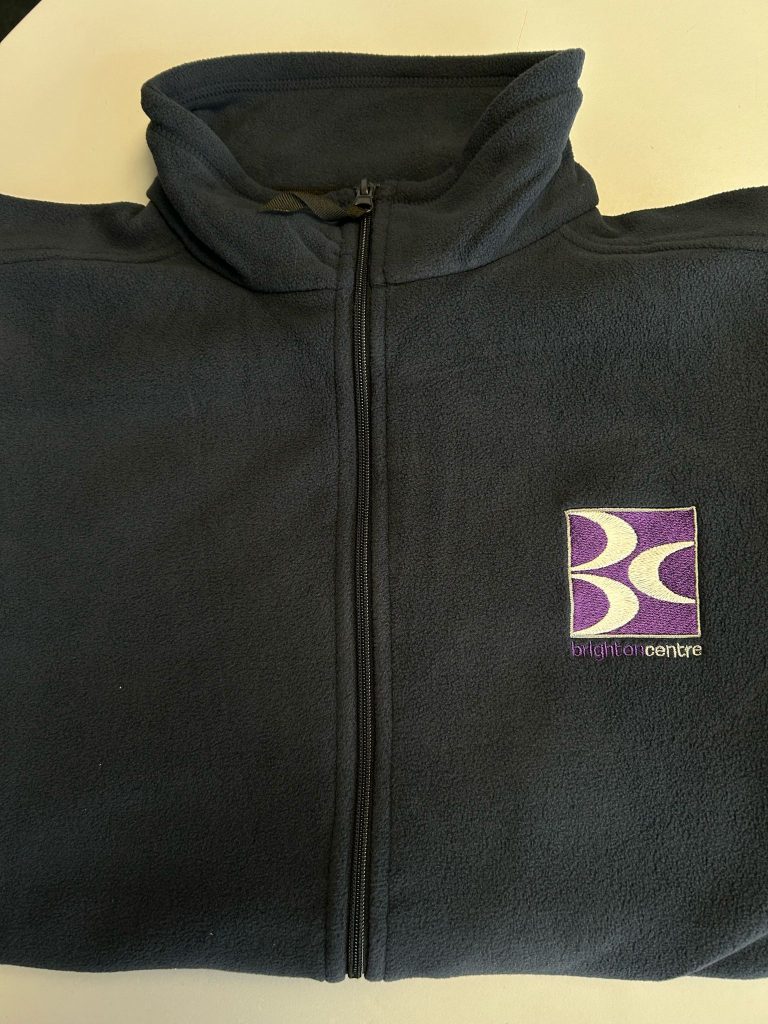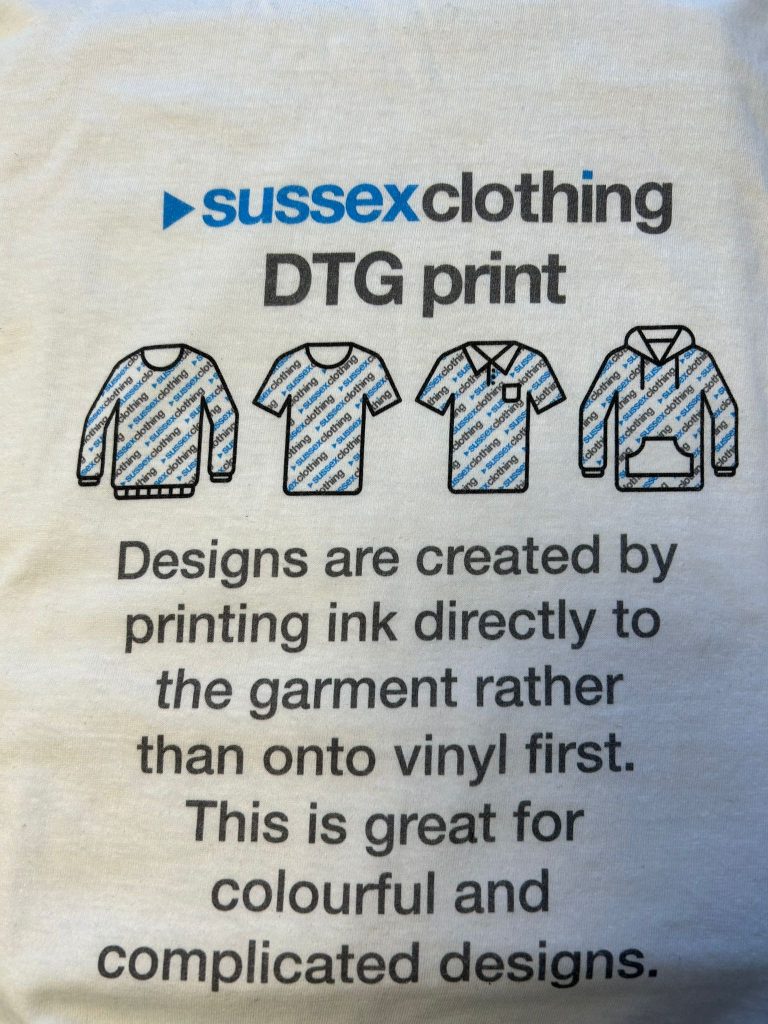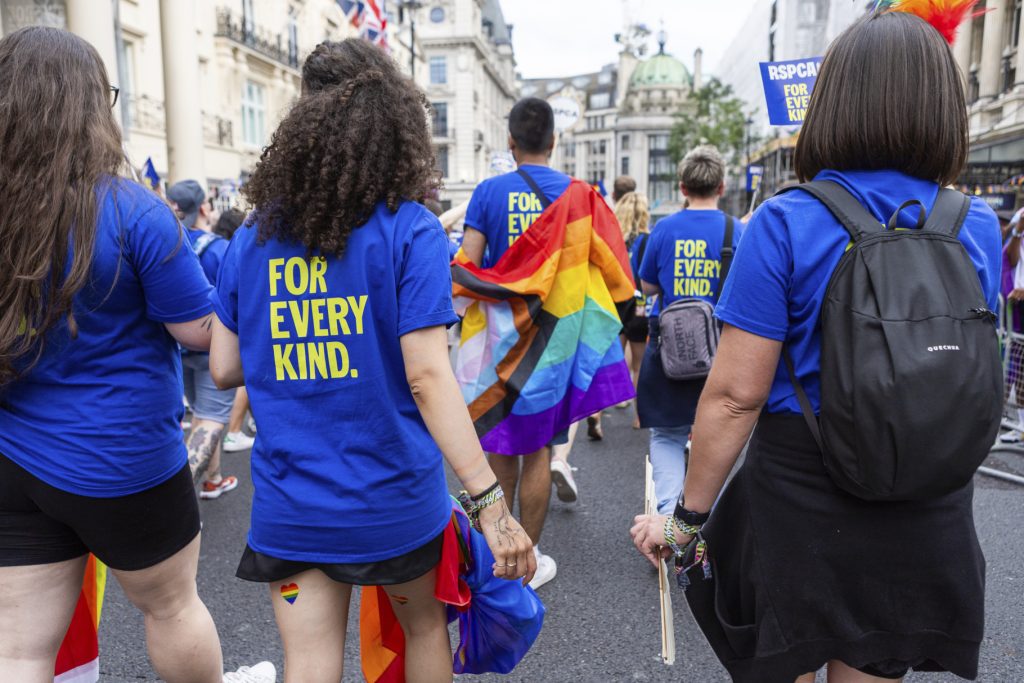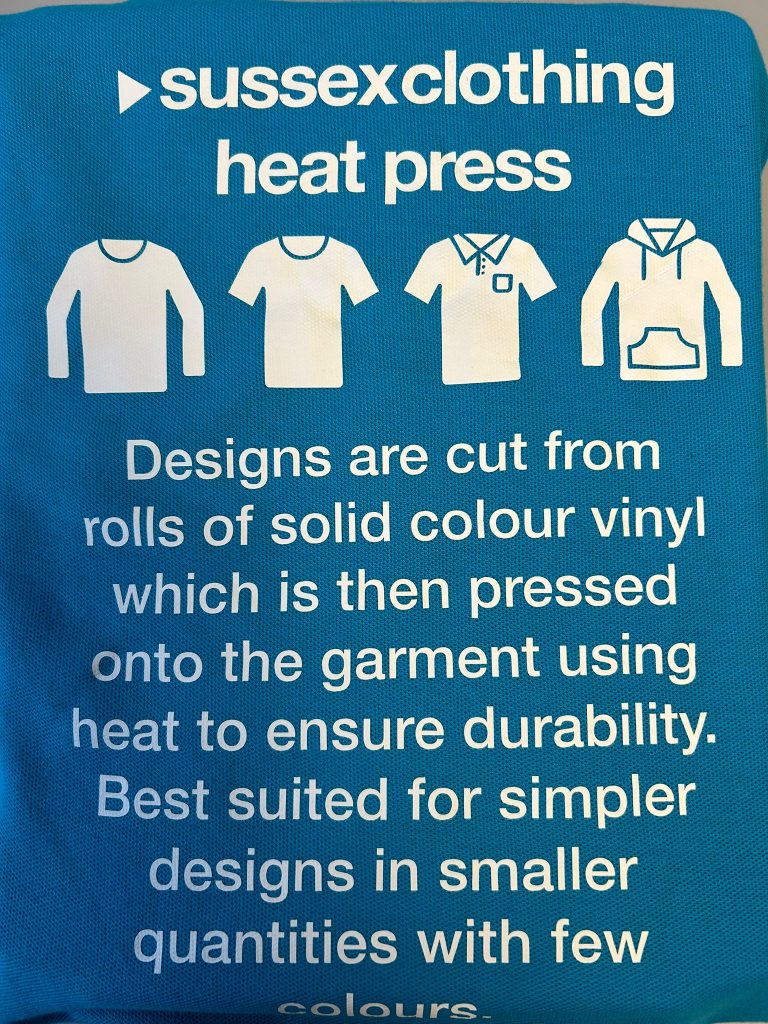Introduction
Customizing your workwear, uniforms or team apparel is a fantastic way to boost your brand and create a professional look. But with so many printing methods out there, how do you know which one to choose?
From embroidery to digital printing, Direct-to-Film (DTF) to vinyl heat press, you’ll learn how each technique works, the pros and the cons.
By the end, you’ll have a clear picture of which method is the perfect fit for your logo or design. Let’s dive in and explore your options for custom workwear printing!
Embroidery – Stitched to Perfection
Embroidery creates a textured, professional look, as seen in this custom embroidered logo for the Brighton Centre

.
How it works:
Embroidery isn’t actually “printing” – it’s the art of stitching your design directly into the fabric with coloured threads. Using state-of-the-art embroidery machines, your logo or artwork is digitized (turned into a stitch pattern) and then sewn onto garments. This results in a raised, textured design that literally becomes part of the clothing. Think of those classy stitched logos on polo shirts or jackets – that’s embroidery in action.
Benefits of Embroidery:
- Professional Look & Feel: Embroidery offers a three-dimensional texture and high-quality finish that instantly conveys professionalism. The stitched design has a tactile feel that looks very high-end, perfect for corporate uniforms, polo shirts, or caps.
- Durability: Because the design is sewn with thread, it’s extremely durable. Embroidered logos can withstand regular wear and frequent washing while maintaining their colour and detail. No worries about your logo rubbing off – it’s literally part of the shirt!
- Colour Flexibility: Embroidery uses thread, so you can include multiple thread colours in your design without affecting cost or complexity. Unlike some printing methods, having, say, 5 different thread colours in an embroidered logo is no problem at all. The result is a vibrant, long-lasting logo with rich colours that pop.
Drawbacks of Embroidery:
- Not Ideal for Photographic Detail: Embroidery is great for logos, but it can’t reproduce photorealistic images or small, intricate details. Fine gradients or small text may not come out clearly in thread form. If your design has a lot of small detail or complex shading, a printing method might capture it better.
- Thickness on Light Fabrics: Large embroidered areas can make a garment a bit stiff or heavy. For example, a giant design on a thin T-shirt will sit poorly and could be a little scratchy. For big back prints or very large designs, Sussex Clothing might suggest a print method instead for comfort.
- Setup Time: Embroidery requires creating a digitized pattern for the machines to follow. This setup is usually a one-time process, but it does add time (and a small setup fee for first-time designs). If you’re in a big rush or only need one extremely detailed piece, digital printing might be quicker.
Despite these minor points, embroidery remains our most popular service for workwear and uniforms – and for good reason. It delivers a premium, long-lasting look. At Sussex Clothing, our embroidery machines can handle everything from single items to bulk orders. If you want that classic, stitched-on look that exudes quality, embroidery is a fantastic choice.
Digital Printing (DTG) – Ink Directly on Fabric
Digital printing (DTG) can reproduce detailed, full-colour designs – even gradients – directly onto garments.

How it works: Digital printing for garments usually refers to Direct-to-Garment (DTG) printing. It’s essentially like using an inkjet printer, but for shirts! A specialized DTG printer sprays water-based textile inks onto the fabric to print your design directly onto the garment. The design is printed in full colour, and the ink heat-cured bonding it to the fabric. There’s no paper transfer or screen stencil – the ink goes straight into the fibres of the clothing. This means you can print very detailed images, even photographs, with precision.
Benefits of Digital Printing:
- High Detail & Colour Range: Digital printing enables photorealistic precision, it can handle designs with lots of colours, detail, and gradients. Your logo or artwork will come out looking exactly as intended, with no loss of detail. This makes DTG ideal for complex multicolour graphics or even full-colour photos printed on a shirt.
- Great for Small Batches or One-Offs: Got a small order or even just one special shirt to make? No problem. DTG requires no lengthy setup (no screens or embroidery patterns to prep). We can print a single shirt for you easily, which is cost-effective for small quantities. You don’t need large orders to make it worthwhile – digital printing is perfect for on-demand prints, prototypes, or personalized gifts.
- Soft Feel (No Bulk): The ink soaks into the fabric making the final print soft to the touch. There’s no additional layer on top of the fabric as there is with vinyl or transfers. This means the printed area stays breathable and lightweight. You can comfortably wear a digitally printed tee without feeling any significant texture on the design area.
- Versatile Placement: Digital printing works well on both light and dark garments of various fabric types. Modern DTG printers can print white ink under the colours, allowing vibrant designs on dark shirts too. 100% cotton fabrics yield the best results, but other materials can work well too.
Drawbacks of Digital Printing:
- Not the Most Durable: Digital prints are durable, but over many washes some fading or cracking may occur. We use high-quality inks and curing processes, so you’ll get many wears out of your printed apparel. Something like embroidery or vinyl might outlast a DTG print in terms of vibrancy over years of heavy use. (Turning printed shirts inside-out before washing helps extend their life, and of course, follow care instructions!)
- Less Economical for Large Orders: DTG one by one is slower and more costly than methods like screen printing. If you need a large run of shirts with a relatively simple design, we recommend other methods to save cost. However, for most small-to-medium workwear orders, digital printing is a convenient choice.
- Fabric Limitations: While DTG can print on a variety of materials, it truly shines on cotton. For specialty fabrics direct digital printing might not adhere or look as good. Don’t worry – that’s where alternatives like DTF printing (next up!) or vinyl transfers come in. We’ll always advise the best method based on the item you choose.
In short, digital printing gives you full-colour, high-detail designs with minimal setup fuss. It’s like bringing photo-quality printing to your workwear. Sussex Clothing’s digital printing service uses top-notch DTG technology to ensure your logos and designs pop with colour and clarity. For a vibrant design or need just a small batch of custom garments, digital printing is an excellent option.
Direct-to-Film (DTF) – The New Kid on the Block
Direct-to-Film (DTF) printing is one of the newer innovations in garment printing, and it’s making waves for its versatility.

How it works: first, we print your design onto a special transparent film using a high-quality printer. Then, we coat the printed design with a powdered adhesive and heat-cure it to the film. Now the design on the film has a glue layer. We place that film on your garment and heat press it, transferring the design from the film onto the fabric. Peel off the film, and voilà – your design is now beautifully bonded to the garment! This method transfers vibrant, high-resolution prints to fabric with excellent detail.
Benefits of DTF Printing:
- Exceptional Versatility: DTF printing works on almost any type of fabric. Cotton, polyester, poly-cotton blends, nylon – you name it. It also isn’t fazed by fabric colour. Unlike some methods that struggle on dark materials, DTF handles darks with ease. DTF prints an opaque white layer behind the design when needed). Whether a black hoodie, neon safety vest, or a canvas tote bag, DTF can likely get the job done. This makes it a go-to for workwear items that other print methods might not handle well.
- High Detail & Vibrancy: DTF produces vibrant, high-resolution prints, capturing fine details and tiny text crisply. It’s fantastic for complex logos or graphics with lots of colours and gradients. The design is first printed on film with precision. Then what you see on the film is exactly what you get on the garment. If your company logo has small lettering or intricate elements, DTF will reproduce them sharply.
- Durability: Designs applied via DTF are durable and wash-resistant. In many cases, DTF prints have excellent longevity, rivalling or even exceeding traditional heat transfers. The adhesive used creates a strong bond to the fabric. You won’t experience the kind of immediate peeling or rapid fading that older iron-on transfer prints sometimes had. With proper care, DTF-printed workwear will hold up to the rigors of the workday and repeated laundering.
- No Minimum Colour Limit: Just like DTG, DTF is a digital process, there’s no limit on the number of colours. You can have a full spectrum in your design (even photographs), and it prints in one go. This makes it good for multicolour logos that would be impractical or costly to do in vinyl or screen printing.
Drawbacks of DTF Printing:
- Slight Texture: A DTF print does add a thin layer on top of the fabric. It’s usually a light, flexible layer – much softer than the old-school thick transfers – but if you have a very large solid design area, you will feel it on the shirt. It’s a bit like a vinyl print in that sense (smooth to the touch), though generally more flexible. Most people find DTF prints comfortable, but it’s worth noting that it’s not as completely imbued in the fabric as DTG ink or as textured as embroidery.
- Relatively New Technique: DTF is the new kid, and not every print shop offers it. Sussex Clothing is proud to use this cutting-edge method, but because it’s newer, some folks might not be as familiar with it. In terms of drawbacks, that’s minor – but with any new tech, quality can depend on using good materials and processes. Rest assured, we use high-quality films, inks and adhesives for professional results.
- Environmental Considerations: There is a bit more material involved (the film and powder) compared to DTG which is just ink on fabric. We make sure to do this process efficiently, but if sustainability is a big concern, you might prefer DTG or embroidery which have slightly less waste. (We do safely dispose of or recycle our excess DTF materials.)
Overall, DTF printing is an excellent choice for detailed, colourful designs on any kind of workwear – especially items that might be tricky for direct printing. It opens up new possibilities for printing on jackets, uniforms, or other work apparel that needs a durable, vibrant logo. We’re excited to offer DTF at Sussex Clothing because it means we can say “yes” to even more of your creative ideas and fabric types. If you’re looking for the latest and greatest in print tech for your custom gear, DTF is it!
Vinyl Printing (Heat Press Vinyl) – Bold and Reliable
Vinyl printing, also known as heat transfer vinyl (HTV) printing, is a tried-and-true method that’s especially popular for lettering and simple graphics.

How it works: It involves cutting your design out of coloured vinyl sheets and then using a heat press to bond that vinyl cut-out onto your garment. Essentially, think of it like creating a custom decal for your shirt. We load a sheet of vinyl (available in tons of colours and finishes) into a cutting machine which slices out your logo or text. After peeling away the excess vinyl, what remains is your design, ready to be heat-pressed. The heat press permanently fuses the vinyl shape onto the fabric. This is the same technique often used for sports jerseys (names and numbers on the back of uniforms are typically vinyl transfers).
Benefits of Vinyl Printing:
- Superb Durability: Vinyl prints are tough. The material is inherently robust – it’s designed to withstand lots of wear and washing without cracking. Your logo will stay bold and intact even after numerous washes. In fact, vinyl graphics often have a longevity comparable to embroidery in terms of surviving the daily grind. This makes vinyl ideal for workwear that sees heavy use or frequent cleaning (e.g., maintenance uniforms, sportswear, etc.).
- Bold Colours & Finish Options: Vinyl yields very vibrant, solid colours with sharp edges. Since the vinyl itself is a pre-coloured material, the hue is usually rich and opaque. Your design will really “pop” with bold colours and crisp lines against the garment. Plus, vinyl comes in specialty finishes – you can get matte, glossy, metallic foil, glitter, reflective vinyl, and more. If you want a gold metallic logo or high-visibility reflective text on a uniform, vinyl makes that possible.
- Great for Personalization: If each piece needs a unique element (like individual names, numbers, or titles), vinyl is a fantastic choice. We can easily cut different names for each shirt without new setup costs. This is why sports team shirts or event staff T-shirts often use vinyl for the personalized touch. It’s cost-effective for small runs and one-off customizations since we’re just cutting letters/designs on the fly rather than making new screens or setups for each variation.
- Ideal for Simple Designs: Have a relatively simple company logo, slogan, or icon that you need on your workwear? Vinyl is a quick and efficient solution. It particularly shines with solid shapes and clean lines – like basic logos, bold text, or two-colour graphics. The result is a sleek and modern appearance with a slightly glossy finish that stands out.
Drawbacks of Vinyl Printing:
- Limited Complexity: Vinyl is not the best for highly detailed or photorealistic designs. Every colour in your design requires a separate vinyl layer to be cut and aligned, so if you have a design with many colours or fine details (like tiny outlines or colour gradients), it becomes impractical. While our team can do multi-layer vinyl prints, for very complex artwork we’d likely recommend digital or DTF printing instead.
- Feel on Garment: A vinyl print sits on top of the fabric as a layer. On a tee or hoodie, you’ll feel the design’s slight texture (it’s smooth and a bit rubbery to touch). Most folks don’t mind this at all – in fact it can give the design a nice presence – but it isn’t as soft as a direct print. Also, large vinyl patches don’t breathe quite as well as ink, so if you cover a big area (say, a giant square logo), that part of the shirt will be less airy. For small chest logos or names, you wouldn’t notice any difference in comfort.
- Preparation Time: Cutting and weeding (removing the excess vinyl) can be a bit labour-intensive for intricate designs. If your logo has a lot of small cut-out sections, it takes extra care to prepare the vinyl. This is usually only a concern for very detailed designs – for simple ones, vinyl prep is quick. Just keep in mind that extremely small text or super-intricate logos might be better suited to print methods to save time and ensure accuracy.
- Potential for Edge Wear: A quality vinyl application, like those we produce at Sussex Clothing, is very durable. But after years of wear, you might see a corner start to lift or a small crack in a heavily stretched area. This often comes down to how the garment is used and cared for (again, turning it inside out to wash is helpful). The good news is, vinyl prints can sometimes be re-pressed to smooth back down if edges ever lift slightly. And if you ever do manage to wear out a vinyl logo, you likely got plenty of mileage out of that garment already!
Despite these considerations, vinyl heat press printing is a fantastic option for bold, long-lasting logos. It’s especially popular for high-visibility workwear, sports kits, and any scenario where durability and standout colour are key. At Sussex Clothing, we have a wide array of vinyl colours and finishes to choose from, and our experts ensure each vinyl logo is applied perfectly (no bubbles, no peeling edges). The result is a crisp, clean logo that can really take a beating – perfect for workwear that works as hard as you do.
Conclusion – Find Your Perfect Fit with Sussex Clothing
Choosing the right printing method for your custom workwear can seem a bit daunting at first, but it really comes down to your specific needs. If you want the ultimate professional look and longevity, you can’t go wrong with classic embroidery.
Need a photorealistic or highly detailed design on a few shirts? Digital DTG printing will make it look amazing. Looking for versatility across fabric types and superb detail? The new DTF printing technique has you covered.
And for bold, solid logos or personalized pieces (like names and numbers) that last, vinyl heat press printing is a winner. Each method has its own charm – from the sheen of thread to the smooth feel of a printed graphic – and there’s no one-size-fits-all answer.
The great news is that Sussex Clothing offers all of these in-house, along with the guidance to help you pick the best one for your project. Our friendly team has years of experience in custom printing and embroidery (we’ve been doing this for over 25 years as part of The Sussex Sign Company!), so we’re here to advise what will work best for your logo, garment choice, and budget.
We pride ourselves on top quality workmanship and excellent customer service. Whether you’re outfitting a small business, a large organization, or just creating a one-off prototype, we’ll make sure your workwear looks fantastic and stands up to the job.
Ready to get your workwear customized?
Let’s make your brand shine! Feel free to contact Sussex Clothing to discuss your ideas or get a quote – we’re always happy to help. You can also check out our Services page for more details on what we offer, or browse our site to see examples of our work.
No matter which printing method you choose, you’ll be in good hands with Sussex Clothing. Let us handle the printing (or stitching!) while you and your team enjoy rocking your new branded gear. We look forward to helping you create workwear that not only looks great, but also represents your brand in the best possible way.
Get in touch with us today and let’s bring your custom workwear vision to life!